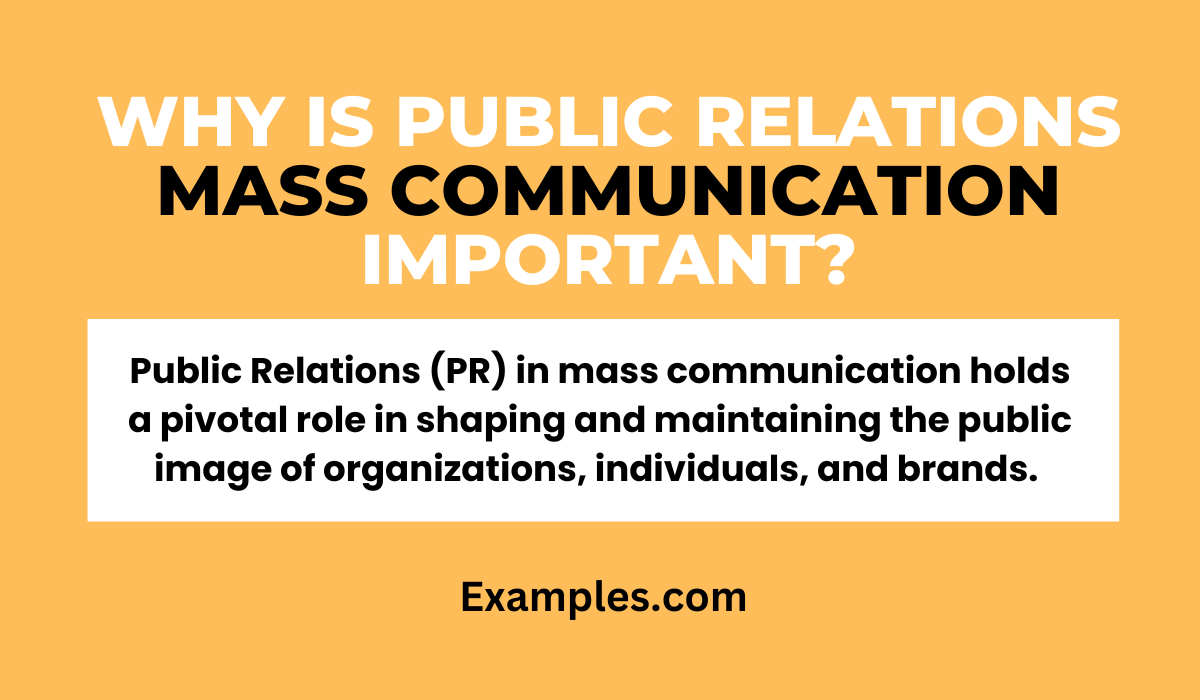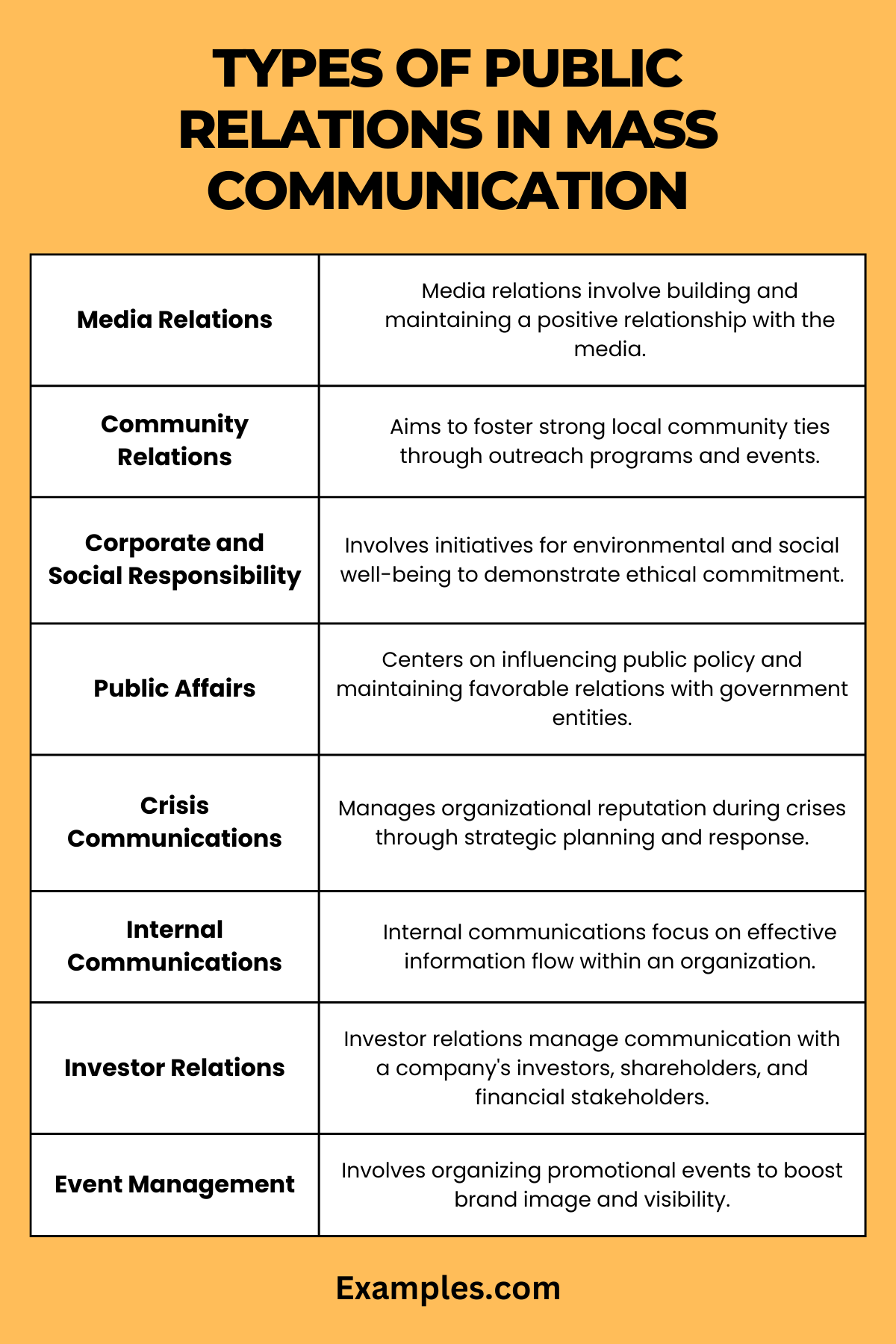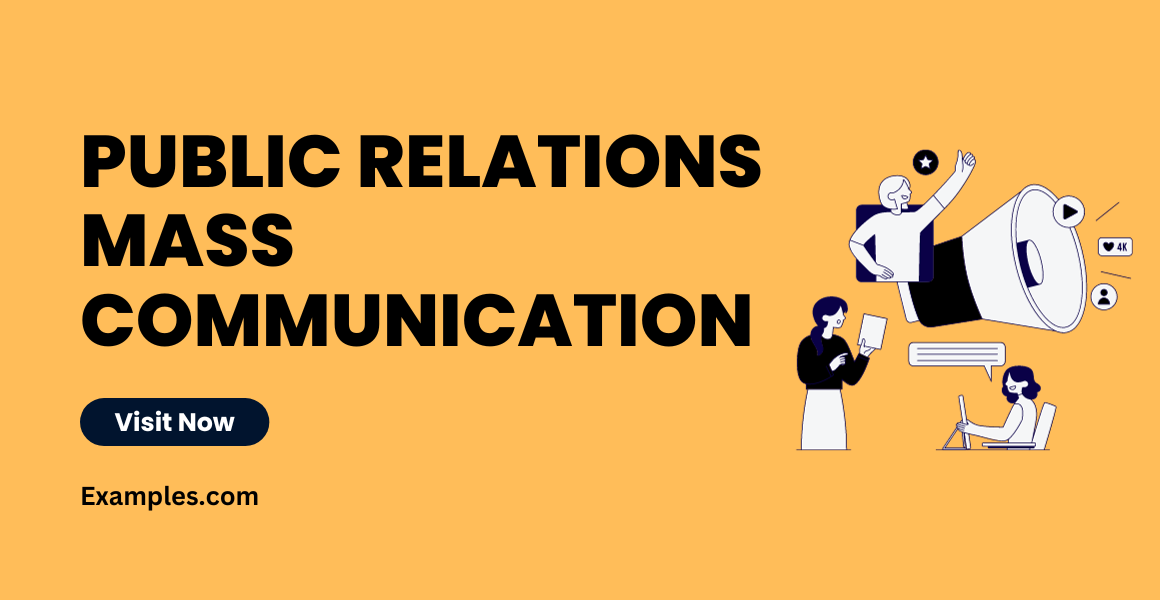49+ Public Relations Mass Communication Examples
Public Relations (PR) in mass communication is an essential strategy for shaping and maintaining the public image of organizations, individuals, or brands. This guide explores the art of PR in the context of mass media, providing insights on how to effectively communicate with and influence the target audience. Through real-world communication examples, learn about crafting compelling narratives, managing media relations, and utilizing various channels to enhance brand visibility and reputation. Whether for crisis management or brand promotion, this guide offers valuable tips and examples for mastering PR in today’s media-centric world.
What is Public Relations Mass Communication?
Public Relations (PR) in mass communication refers to the strategic process of managing information and relationships between organizations, individuals, or brands, and the public. It involves creating and maintaining a positive image and a strong relationship with the target audience through various communication channels. PR strategies include media relations, crisis management, and event planning, all aimed at shaping public perception, building brand awareness, and fostering trust. This field is essential for effective brand messaging and maintaining a favorable public image in the competitive media landscape.
50 Public Relations Mass Communication Examples
Public Relations (PR) in mass communication encompasses a variety of strategies and tactics used by organizations, individuals, and brands to shape their public image and communicate effectively with their audience. This collection presents 50 unique and distinct examples of PR in action, illustrating the diverse ways in which PR can be leveraged to manage reputations, respond to crises, engage with the public, and promote brand messages. These examples, ranging from press releases to social media campaigns, highlight the integral role of PR in building and maintaining a positive public presence in today’s media-driven world.
- Launching a New Product: “Our latest smartphone model combines cutting-edge technology with user-friendly features.” This press release introduces a new product, aiming to generate media interest and consumer excitement.
- Managing a Crisis Situation: “We are committed to addressing this issue transparently and will take all necessary steps to ensure it doesn’t recur.” A statement like this is essential in crisis communication to maintain public trust.
- Hosting a Charity Event: “Join us for our annual charity gala to support local communities and make a difference.” PR involves event promotion to enhance brand image and community engagement.
- Responding to Customer Complaints on Social Media: “We apologize for the inconvenience and are working swiftly to resolve this matter.” Public responses to customer issues on social media are crucial for reputation management.
- Celebrity Endorsement Deals: “We’re excited to partner with [Celebrity Name] to bring a new perspective to our brand.” Celebrity endorsements are a PR strategy to attract attention and add credibility.
- Environmental Sustainability Initiatives: “Our commitment to sustainability is at the forefront of our new green policy.” Announcing eco-friendly initiatives improves brand image and appeals to environmentally conscious consumers.
- Collaborating with Influencers: “We’ve teamed up with [Influencer Name] to showcase our latest collection.” Influencer collaborations on social media are effective for reaching wider audiences.
- Hosting Press Conferences: “We invite the press to discuss our upcoming major project that will revolutionize the industry.” Press conferences are a direct way to communicate with media representatives.
- Publishing White Papers: “Our white paper details the latest research and advancements in renewable energy.” White papers are used to establish authority and expertise in an industry.
- Employee Advocacy Programs: “Our employees are our biggest ambassadors, sharing their experiences working with us.” Encouraging employees to share positive aspects of the company enhances internal and external PR.

- Sponsorship of Sporting Events: “We are proud to be the official sponsor of this year’s marathon.” Sponsorships increase visibility and associate brands with positive community events.
- Community Outreach Programs: “Our community program focuses on educational development in underserved areas.” Community outreach enhances corporate social responsibility and public image.
- Public Apologies for Missteps: “We sincerely apologize for the oversight and are taking corrective action.” Public apologies in response to errors or controversies are vital for damage control.
- Collaboration with Non-Profits: “Our partnership with [Non-Profit Name] aims to address global water scarcity.” Collaborations with non-profits can improve brand perception and show social commitment.
- Launching Public Health Campaigns: “Our campaign focuses on raising awareness about mental health issues.” Health campaigns demonstrate a brand’s commitment to societal well-being.
- Developing Educational Content: “Our educational series on financial literacy is available to everyone.” Providing educational content positions a brand as helpful and informative.
- Hosting Webinars and Online Talks: “Join our webinar to learn about the latest trends in digital marketing.” Webinars are an effective way to engage with a target audience and share expertise.
- Social Media Challenges and Campaigns: “Participate in our #GoGreenChallenge to show your support for the environment.” Social media campaigns can go viral, increasing engagement and brand visibility.

- Advocacy for Social Issues: “We stand in support of equal rights and inclusivity in our industry.” Advocacy shows a brand’s values and can resonate with like-minded audiences.
- Public Relations Surveys and Reports: “Our annual report reveals consumer trends and preferences in online shopping.” Surveys and reports provide valuable insights and highlight a brand’s research capabilities.
- Content Marketing with PR Angles: “Our blog covers the latest in sustainable living, offering practical tips for everyday life.” Content marketing blended with PR angles offers value and enhances SEO.
- Company Milestone Celebrations: “Celebrating 25 years of innovation and excellence in the tech industry.” Milestone celebrations are used to generate positive media coverage and engage stakeholders.
- Employee Recognition Programs: “Our Employee of the Month initiative showcases the incredible talent within our team.” Recognizing employees publicly boosts morale and shows a positive company culture.
- Public Safety Announcements: “Our safety campaign advises on precautions during extreme weather conditions.” Safety announcements show a brand’s concern for public well-being.
- Publishing Annual Sustainability Reports: “Our report highlights our progress in reducing carbon emissions over the past year.” Sustainability reports demonstrate a commitment to environmental responsibility.
- Corporate Social Responsibility (CSR) Initiatives: “Our CSR initiative focuses on empowering women entrepreneurs globally.” CSR initiatives enhance a brand’s reputation and contribute to social causes.
- Rebranding Announcements: “Our new brand identity reflects our evolution and future direction.” Rebranding can rejuvenate a brand’s image and attract new interest.

- Public Speaking Engagements: “Our CEO will speak about the future of AI at the Global Tech Conference.” Public speaking engagements position company leaders as industry thought leaders.
- Employee Volunteer Programs: “Our team volunteered at the local food bank, supporting community efforts.” Volunteer programs improve public perception and encourage team bonding.
- Hosting Industry Panels and Discussions: “Join our panel discussion on the impact of AI in healthcare.” Panels and discussions promote knowledge exchange and position the brand as an industry leader.
- Internal Communications: “Our internal newsletter keeps employees informed and engaged with company updates.” Effective internal communications foster a positive work environment and informed staff.
- Media Training for Executives: “Our executives undergo media training to effectively represent our brand in interviews.” Media training ensures that company representatives communicate effectively in public settings.
- User-Generated Content Campaigns: “Share your experience with our product using #MyStory for a chance to be featured.” Encouraging user-generated content increases engagement and provides authentic promotional material.
- Press Kit Development: “Our press kit provides media with comprehensive information about our latest project.” Press kits are essential tools for providing media with relevant company information.
- Hosting VIP and Media Events: “We invite media and influencers to experience our new resort’s grand opening.” Exclusive events generate media coverage and create buzz around new offerings.
- Developing Infographics for Public Education: “Our infographics simplify complex data about climate change.” Infographics are effective in educating the public on various topics.
- Leveraging Podcasts for Brand Messaging: “Our podcast series discusses the challenges and innovations in renewable energy.” Podcasts are a growing medium for storytelling and brand messaging.
- Brand Storytelling in Advertising: “Our ad campaign tells the story of our brand’s heritage and craftsmanship.” Storytelling in advertising connects emotionally with the audience and enhances brand loyalty.
- Corporate Blogging: “Our corporate blog offers insights into industry trends and company developments.” Blogging is an effective way to share expertise and news.
- Crisis Communication Plans: “Our crisis plan ensures timely and transparent communication in emergency situations.” Crisis plans are crucial for managing public perception during challenging times.
- Thought Leadership Articles: “Our articles on industry innovations position us as thought leaders.” Thought leadership content builds credibility and authority in a field.
- Engaging with Online Communities: “We actively engage in online forums related to our industry.” Participating in online communities helps build relationships and brand presence.
- Developing Case Studies and Success Stories: “Our case studies showcase the impact of our solutions on clients.” Case studies provide real-world examples of a brand’s effectiveness.
- Corporate Philanthropy and Giving: “Our annual charity drive supports local schools and educational programs.” Philanthropic efforts enhance a brand’s image and community involvement.
- Influencer Meetups and Events: “We host events where influencers can experience our products firsthand.” Influencer events generate content and endorsements for the brand.
- Public Opinion Polls: “Our polls gauge public opinion on key environmental issues.” Opinion polls help understand public sentiment and inform PR strategies.
- Video Marketing for PR: “Our video series highlights customer stories and experiences with our brand.” Video marketing is a compelling way to convey brand stories.
- Public Exhibitions and Showcases: “We exhibit our latest innovations at the annual Tech Expo.” Exhibitions are opportunities to showcase products and engage with a wide audience.
- Investor Relations Communications: “We communicate regularly with investors through updates and annual reports.” Investor relations ensure transparency and confidence among shareholders.
- Sustainability and Green Initiatives: “Our green initiatives demonstrate our commitment to environmental responsibility.” Promoting sustainability initiatives enhances brand image and attracts eco-conscious consumers.
Why Is Public Relations Mass Communication Important?
Public Relations (PR) in mass communication holds a pivotal role in shaping and maintaining the public image of organizations, individuals, and brands. It’s an integral part of the communication strategy that impacts how entities are perceived and received by the public. This guide delves into the significance of PR in mass communication, highlighting its key aspects and the value it brings.

Building and Maintaining a Positive Image
- Public Perception Management: PR strategies are essential in crafting and upholding a positive public image, influencing how an organization or individual is perceived by the public.
- Brand Identity and Consistency: Consistent PR efforts help in establishing and maintaining a strong brand identity, essential for long-term success in a competitive marketplace.
Crisis Management and Damage Control
- Navigating Public Relations Crises: Effective PR is crucial in managing crises, helping organizations navigate through difficult situations while minimizing reputational damage.
- Maintaining Trust and Credibility: Timely and transparent communication during crises is key to maintaining public trust and credibility, aspects that are vital for any entity’s longevity.
Enhancing Community Relations and Engagement
- Community Outreach and Involvement: PR facilitates community engagement, allowing organizations to build and foster relationships with various stakeholders, including local communities, customers, and partners.
- Social Responsibility and Image: Through community relations, entities demonstrate their commitment to social responsibility, enhancing their public image and societal impact.
Influencing Public Opinion and Behavior
- Shaping Public Opinion: PR tools and tactics are used to influence public opinion, making it a powerful component in shaping societal norms and perceptions.
- Driving Behavior Change: By communicating targeted messages, PR can effectively drive behavioral changes, whether it’s encouraging product usage or promoting social causes.
Supporting Marketing and Promotional Efforts
- Integrated Marketing Communications: PR complements marketing efforts, ensuring consistent messaging across all platforms, contributing to a unified brand voice.
- Boosting Campaign Effectiveness: Through media relations and storytelling, PR can significantly amplify the reach and impact of marketing campaigns.
Facilitating Internal Communication and Morale
- Strengthening Internal Communications: PR is not just external; it plays a vital role in internal communications, keeping employees informed and engaged.
- Boosting Employee Morale and Brand Advocacy: Effective internal PR fosters a positive work environment, turning employees into brand advocates.
Gaining Competitive Advantage
- Differentiating in the Marketplace: A strong PR strategy can set an entity apart from its competitors, providing a unique competitive edge.
- Attracting Opportunities and Partnerships: Positive public relations opens doors for new business opportunities and strategic partnerships, crucial for growth and expansion.
Public Relations Mass Communication is not just about handling the press; it’s a strategic approach to maintaining a positive public presence, managing crises, engaging with communities, influencing opinions, supporting marketing efforts, and gaining a competitive edge. It’s an indispensable tool for any entity looking to thrive in today’s media-driven world.
What are the Types of Public Relations Mass Communication?
Public Relations (PR) in mass communication encompasses various types, each serving a specific purpose and employing different strategies to manage and enhance the public image of organizations, individuals, or brands. Understanding these types is crucial for effectively navigating the diverse landscape of PR. Below, we explore the key types of public relations in mass communication, highlighting their unique features and applications.

Media Relations
Media relations involve building and maintaining a positive relationship with the media.
- Purpose: To ensure fair and favorable media coverage for an organization or individual.
- Application: Involves press releases, media briefings, interviews, and responding to media inquiries.
Community Relations
Community relations focus on establishing and nurturing a positive relationship with the local community.
- Purpose: To build a strong local presence and foster goodwill among community members.
- Application: Includes community outreach programs, local events, sponsorships, and charitable initiatives.
Corporate and Social Responsibility (CSR)
CSR refers to a company’s initiatives to assess and take responsibility for its effects on environmental and social well-being.
- Purpose: To demonstrate a commitment to ethical practices and contribute to societal improvement.
- Application: Involves sustainable business practices, environmental initiatives, and supporting social causes.
Public Affairs
Public affairs relate to building relationships with governmental bodies and public officials.
- Purpose: To influence public policy and maintain a favorable legislative environment.
- Application: Includes lobbying, legislative monitoring, and governmental relations programs.
Crisis Communications
Crisis communications involve managing an organization’s reputation in the wake of adverse events.
- Purpose: To minimize damage and maintain trust during and after a crisis.
- Application: Includes crisis planning, immediate response strategies, and post-crisis analysis.
Internal Communications
Internal communications focus on effective information flow within an organization.
- Purpose: To keep employees informed, engaged, and aligned with the company’s goals.
- Application: Involves employee newsletters, intranet, internal announcements, and feedback channels.
Investor Relations
Investor relations manage communication with a company’s investors, shareholders, and financial stakeholders.
- Purpose: To provide accurate and timely information to financial stakeholders.
- Application: Includes financial reporting, shareholder meetings, investor presentations, and annual reports.
Consumer or Customer Relations
Consumer relations are about building and maintaining relationships with customers.
- Purpose: To enhance customer satisfaction and loyalty.
- Application: Involves customer service initiatives, feedback mechanisms, loyalty programs, and engagement campaigns.
Event Management
Event management in PR involves organizing events to promote a brand or cause.
- Purpose: To create impactful experiences that enhance brand image and visibility.
- Application: Includes press conferences, product launches, exhibitions, and promotional events.
Online and Social Media Relations
Online and social media relations involve managing an organization’s presence on digital platforms.
- Purpose: To engage with the online community and manage the brand’s digital presence.
- Application: Includes content creation, social media campaigns, influencer partnerships, and online reputation management.
Each type of public relations plays a vital role in the overall PR strategy, catering to different aspects of an organization’s communication needs. From maintaining media relationships to managing crises, the multifaceted nature of PR in mass communication is essential for building and sustaining a positive public image.
How to Implement Public Relations in Mass Communication
Implementing public relations (PR) in mass communication is a strategic process that involves various steps and considerations. It requires a clear understanding of the organization’s goals, the target audience, and the most effective communication channels. Here’s a comprehensive guide on how to effectively implement PR strategies in the realm of mass communication.
Understanding Your Objectives
- Define Clear Goals: Establish what you want to achieve with your PR efforts, whether it’s enhancing brand visibility, managing a crisis, or improving public perception.
- Align with Business Strategy: Ensure that your PR objectives are in sync with the overall business or organizational strategy for cohesive messaging.
Identifying the Target Audience
- Audience Analysis: Determine who your target audience is, including their demographics, interests, and media consumption habits.
- Tailored Messaging: Develop messages that resonate with your target audience and address their specific needs or interests.
Choosing the Right Channels
- Media Selection: Choose appropriate media channels for your PR campaigns, whether traditional media like newspapers and TV or digital platforms like social media and blogs.
- Channel Diversification: Utilize a mix of different channels to reach a broader audience and reinforce your message.
Crafting Compelling Content
- Message Development: Create content that is engaging, informative, and aligns with your PR goals.
- Consistency: Maintain a consistent tone and style across all your communications to strengthen brand identity.
Building Media Relationships
- Media Outreach: Develop relationships with journalists, bloggers, and influencers who can help amplify your message.
- Press Releases and Media Kits: Provide media professionals with all the necessary information about your campaigns or events.
Monitoring and Evaluation
- Track Media Coverage: Regularly monitor how your PR campaigns are being covered in the media.
- Evaluate Performance: Use metrics like media impressions, engagement rates, and audience sentiment to assess the effectiveness of your PR efforts.
Engaging with the Audience
- Interactive Communication: Foster two-way communication with your audience through social media, surveys, and public events.
- Feedback Loop: Listen to the audience feedback and adjust your strategies accordingly.
Crisis Management
- Crisis Plan: Have a crisis communication plan in place to quickly and effectively respond to any negative situations.
- Timely Response: Address issues promptly to control the narrative and minimize damage to your brand’s reputation.
Utilizing Digital PR
- Online Presence: Maintain an active and engaging online presence through websites, blogs, and social media.
- SEO and Content Marketing: Use SEO strategies and content marketing to enhance your online visibility and reach.
Continuous Learning and Adaptation
- Stay Informed: Keep up-to-date with the latest trends in PR and mass communication.
- Adapt and Innovate: Be open to adapting your strategies based on changing media landscapes and audience preferences.
Implementing public relations in mass communication is an ongoing process that requires attention to detail, creativity, and adaptability. By following these steps, organizations can effectively manage their public image, communicate their messages, and build lasting relationships with their audience.
Tips for Effective Public Relations in Mass Communication
Effective public relations (PR) in mass communication is key to shaping and maintaining a positive public image for any organization or individual. It involves strategic planning, clear communication, and a deep understanding of the target audience. Here are some essential tips to ensure your PR efforts in mass communication are successful and impactful.
Know Your Audience
- Understand Demographics: Familiarize yourself with the age, gender, interests, and media habits of your target audience.
- Tailor Your Message: Customize your communication to resonate with your audience, ensuring relevance and engagement.
Develop a Strong PR Strategy
- Set Clear Goals: Define what you want to achieve with your PR campaign, whether it’s brand awareness, crisis management, or audience engagement.
- Plan Meticulously: Outline a comprehensive plan that covers all aspects of your campaign, from messaging to media channels.
Create Compelling Content
- Engaging Storytelling: Use storytelling to make your content more engaging and relatable to your audience.
- Consistency is Key: Ensure that your content is consistent in tone and style across all platforms.
Build Relationships with the Media
- Cultivate Media Contacts: Establish and maintain relationships with journalists, bloggers, and influencers in your industry.
- Effective Press Releases: Write clear, concise, and newsworthy press releases that capture the media’s attention.
Utilize Digital Platforms
- Embrace Social Media: Leverage social media platforms to reach a wider audience and engage with them directly.
- Monitor Online Presence: Regularly monitor your online reputation and respond to feedback appropriately.
Engage in Two-Way Communication
- Encourage Feedback: Invite your audience to share their opinions and feedback, showing that you value their input.
- Active Listening: Pay attention to what your audience is saying about your brand and respond thoughtfully.
Be Proactive and Reactive
- Anticipate Trends: Stay ahead of industry trends and adjust your PR strategies accordingly.
- Crisis Management: Have a crisis management plan in place and be ready to respond swiftly and effectively in challenging situations.
Measure and Analyze Your Efforts
- Track Performance: Use analytics tools to measure the effectiveness of your PR campaigns.
- Learn and Adapt: Analyze results and be willing to adapt your strategies for better outcomes.
Foster Transparency and Honesty
- Be Transparent: Maintain transparency in your communication to build trust with your audience.
- Honesty is the Best Policy: Be honest in your messaging, especially in times of crisis.
Continuous Learning and Improvement
- Stay Informed: Keep up with the latest developments in PR and mass communication.
- Seek Feedback for Improvement: Regularly seek feedback from your team and audience to continuously improve your PR efforts.
By following these tips, you can ensure that your public relations efforts in mass communication are not only effective but also leave a lasting positive impact on your audience. Successful PR is about building trust, engaging with your audience, and consistently delivering value through your communications.
In conclusion, Public Relations in Mass Communication plays a pivotal role in shaping perceptions, managing reputations, and fostering positive relationships between organizations and their varied audiences. From media relations to crisis management, PR’s multifaceted approach in today’s interconnected world is indispensable for building trust, ensuring effective communication, and maintaining a favorable public image in an ever-evolving media landscape.



